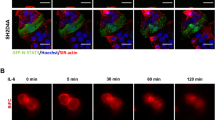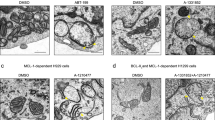Abstract
AAA domain containing 3A (ATAD3A) is an integral mitochondrial membrane protein with unknown function, although we now show that high-level expression is associated with poor survival in breast cancer patients. Using a mass spectrometry approach we have demonstrated that ATAD3A interacts with the WASF3 metastasis-promoting protein. Knockdown of ATAD3A leads to decreased WASF3 protein levels in breast and colon cancer cells. Silencing ATAD3A also results in loss of both cell anchorage-independent growth and invasion and suppression of tumor growth and metastasis in vivo using immuno-compromised mice. HSP70 is responsible for stabilizing WASF3 in the cytoplasm, but inactivation of HSP70 does not lead to the loss of WASF3 stability at the mitochondrial membrane, where presumably it is protected through its interaction with ATAD3A. In response to endoplasmic reticulum (ER) stress, increases in the GRP78 protein level leads to increased WASF3 protein levels. We also show that ATAD3A was present in a WASF3-GRP78 complex, and suppression of GRP78 led to destabilization of WASF3 at the mitochondrial membrane, which was ATAD3A dependent. Furthermore, ATAD3A-mediated suppression of CDH1/E-cadherin occurs through its regulation of GRP78-mediated WASF3 stability. Proteolysis experiments using isolated mitochondria demonstrates the presence of the N-terminal end of WASF3 within the mitochondria, which is the interaction site with the N-terminal end of ATAD3A. It appears, therefore, that stabilization of WASF3 function occurs through its interaction with ATAD3A and GRP78, which may provide a bridge between the ER and mitochondria, allowing communication between the two organelles. These findings also suggest that pharmacologic inhibition of ATAD3A could be an effective therapeutic strategy to treat human cancer.
This is a preview of subscription content, access via your institution
Access options
Subscribe to this journal
Receive 50 print issues and online access
$259.00 per year
only $5.18 per issue
Buy this article
- Purchase on Springer Link
- Instant access to full article PDF
Prices may be subject to local taxes which are calculated during checkout






Similar content being viewed by others
Accession codes
References
Sossey-Alaoui K, Su G, Malaj E, Roe B, Cowell JK . WAVE3 an actin-polymerization gene, is truncated and inactivated as a result of a constitutional t(1;13)(q21;q12) chromosome translocation in a patient with ganglioneuroblastoma. Oncogene 2002; 21: 5967–5974.
Rotty JD, Wu C, Bear JE . New insights into the regulation and cellular functions of the ARP2/3 complex. Nat Rev Mol Cell Biol 2013; 14: 7–12.
Sossey-Alaoui K, Head K, Nowak N, Cowell JK . Genomic organization and expression profile of the human and mouse WAVE gene family. Mamm Genome 2003; 14: 314–322.
Bisi S, Disanza A, Malinverno C, Frittoli E, Palamidessi A, Scita G . Membrane and actin dynamics interplay at lamellipodia leading edge. Curr Opin Cell Biol 2013; 25: 565–573.
Sossey-Alaoui K, Li X, Ranalli TA, Cowell JK . WAVE3-mediated cell migration and lamellipodia formation are regulated downstream of phosphatidylinositol 3-kinase. J Biol Chem 2005; 280: 21748–21755.
Sossey-Alaoui K, Li X, Cowell JK . c-Abl-mediated phosphorylation of WAVE3 is required for lamellipodia formation and cell migration. J Biol Chem 2007; 282: 26257–26265.
Teng Y, Ghoshal P, Ngoka L, Mei Y, Cowell JK . Critical role of the WASF3 gene in JAK2/STAT3 regulation of cancer cell motility. Carcinogenesis 2013; 34: 1994–1999.
Prat A, Parker JS, Karginova O, Fan C, Livasy C, Herschkowitz JI et al. Phenotypic and molecular characterization of the claudin-low intrinsic subtype of breast cancer. Breast Cancer Res 2010; 12: R68.
Sossey-Alaoui K, Safina A, Li X, Vaughan MM, Hicks DG, Bakin AV et al. Down-regulation of WAVE3, a metastasis promoter gene, inhibits invasion and metastasis of breast cancer cells. Am J Pathol 2007; 170: 2112–2121.
Teng Y, Ren MQ, Cheney R, Sharma S, Cowell JK . Inactivation of the WASF3 gene in prostate cancer cells leads to suppression of tumorigenicity and metastases. Br J Cancer 2010; 103: 1066–1075.
Teng Y, Liu M, Cowell JK . Functional interrelationship between the WASF3 and KISS1 metastasis-associated genes in breast cancer cells. Int J Cancer 2011; 129: 2825–2835.
Teng Y, Mei Y, Hawthorn L, Cowell JK . WASF3 regulates miR-200 inactivation by ZEB1 through suppression of KISS1 leading to increased invasiveness in breast cancer cells. Oncogene 2014; 33: 203–211.
Teng Y, Ngoka L, Mei Y, Lesoon L, Cowell JK . HSP90 and HSP70 proteins are essential for stabilization and activation of WASF3 metastasis-promoting protein. J Biol Chem 2012; 287: 10051–10059.
He J, Mao CC, Reyes A, Sembongi H, Di Re M, Granycome C et al. The AAA+ protein ATAD3 has displacement loop binding properties and is involved in mitochondrial nucleoid organization. J Cell Biol 2007; 176: 141–146.
Bogenhagen DF, Rousseau D, Burke S . The layered structure of human mitochondrial DNA nucleoids. J Biol Chem 2008; 283: 3665–3675.
Merle N, Féraud O, Gilquin B, Hubstenberger A, Kieffer-Jacquinot S, Assard N et al. ATAD3B is a human embryonic stem cell specific mitochondrial protein, re-expressed in cancer cells, that functions as dominant negative for the ubiquitous ATAD3 A. Mitochondrion 2012; 12: 441–448.
Gilquin B, Taillebourg E, Cherradi N, Hubstenberger A, Gay O, Merle N et al. The AAA+ ATPase ATAD3 A controls mitochondrial dynamics at the interface of the inner and outer membranes. Mol Cell Biol 2010; 30: 1984–1996.
Hubstenberger A, Labourdette G, Baudier J, Rousseau D . ATAD 3 A and ATAD 3B are distal 1p-located genes differentially expressed in human glioma cell lines and present in vitro anti-oncogenic and chemoresistant properties. Exp Cell Res 2008; 314: 2870–2883.
You WC, Chiou SH, Huang CY, Chiang SF, Yang CL, Sudhakar JN et al. Mitochondrial protein ATPase family, AAA domain containing 3A correlates with radioresistance in glioblastoma. Neuro Oncol 2013; 15: 1342–1352.
Chiang SF, Huang CY, Lin TY, Chiou SH, Chow KC . An alternative import pathway of AIF to the mitochondria. Int J Mol Med 2012; 29: 365–372.
Chen TC, Hung YC, Lin TY, Chang HW, Chiang IP, Chen YY et al. Human papillomavirus infection and expression of ATPase family AAA domain containing 3A, a novel anti-autophagy factor, in uterine cervical cancer. Int J Mol Med 2011; 28: 689–696.
Fang HY, Chang CL, Hsu SH, Huang CY, Chiang SF, Chiou SH et al. ATPase family AAA domain-containing 3A is a novel anti-apoptotic factor in lung adenocarcinoma cells. J Cell Sci 2010; 123: 1171–1180.
Iorns E, Drews-Elger K, Ward TM, Dean S, Clarke J, Berry D et al. A new mouse model for the study of human breast cancer metastasis. PLoS One 2012; 7: e47995.
Leu JI, Pimkina J, Frank A, Murphy ME, George DL . A small molecule inhibitor of inducible heat shock protein 70. Mol Cell 2009; 36: 15–27.
Lee AS . GRP78 induction in cancer: therapeutic and prognostic implications. Cancer Res 2007; 67: 3496–3499.
Grkovic S, O'Reilly VC, Han S, Hong M, Baxter RC, Firth SM . IGFBP-3 binds GRP78, stimulates autophagy and promotes the survival of breast cancer cells exposed to adverse microenvironments. Oncogene 2013; 32: 2412–2420.
Li N, Zoubeidi A, Beraldi E, Gleave ME . GRP78 regulates clusterin stability, retrotranslocation and mitochondrial localization under ER stress in prostate cancer. Oncogene 2013; 32: 1933–1942.
Sun FC, Wei S, Li CW, Chang YS, Chao CC, Lai YK . Localization of GRP78 to mitochondria under the unfolded protein response. Biochem J 2006; 396: 31–39.
Reddy RK, Mao C, Baumeister P, Austin RC, Kaufman RJ, Lee AS . Endoplasmic reticulum chaperone protein GRP78 protects cells from apoptosis induced by topoisomerase inhibitors: role of ATP binding site in suppression of caspase-7 activation. J Biol Chem 2003; 278: 20915–20924.
Dong D, Stapleton C, Luo B, Xiong S, Ye W, Zhang Y et al. A critical role for GRP78/BiP in the tumor microenvironment for neovascularization during tumor growth and metastasis. Cancer Res 2011; 71: 2848–2857.
Maître JL, Heisenberg CP . Three functions of cadherins in cell adhesion. Curr Biol 2013; 23: R626–R633.
Sotomayor M, Gaudet R, Corey DP . Sorting out a promiscuous superfamily: towards cadherin connectomics. Trends Cell Biol 2014; 24: 524–536.
Kamath RS, Fraser AG, Dong Y, Poulin G, Durbin R, Gotta M et al. Systematic functional analysis of the Caenorhabditis elegans genome using RNAi. Nature 2003; 421: 231–237.
Hoffmann M, Bellance N, Rossignol R, Koopman WJ, Willems PH, Mayatepek E et al. C. elegans ATAD-3 is essential for mitochondrial activity and development. PLoS One 2009; 4: e7644.
Goller T, Seibold UK, Kremmer E, Voos W, Kolanus W . Atad3 function is essential for early post-implantation development in the mouse. PLoS One 2013; 8: e54799.
Ogaeri T, Eto K, Otsu M, Ema H, Nakauchi H . The actin polymerization regulator WAVE2 is required for early bone marrow repopulation by hematopoietic stem cells. Stem Cells 2009; 27: 1120–1129.
Dahl JP, Wang-Dunlop J, Gonzales C, Goad ME, Mark RJ, Kwak SP . Characterization of the WAVE1 knock-out mouse: implications for CNS development. J Neurosci 2003; 23: 3343–3352.
Rawe VY, Ramalho-Santos J, Payne C, Chemes HE, Schatten G . WAVE1 an A-kinase anchoring protein, during mammalian spermatogenesis. Hum Reprod 2004; 19: 2594–2604.
Beene DL, Scott JD . A-kinase anchoring proteins take shape. Curr Opin Cell Biol 2007; 19: 192–198.
Danial NN, Gramm CF, Scorrano L, Zhang CY, Krauss S, Ranger AM et al. BAD and glucokinase reside in a mitochondrial complex that integrates glycolysis and apoptosis. Nature 2003; 424: 952–956.
Yang J, Li JH, Wang J, Zhang CY . Molecular modeling of BAD complex resided in a mitochondrion integrating glycolysis and apoptosis. J Theor Biol 2010; 266: 231–241.
Luo B, Lee AS . The critical roles of endoplasmic reticulum chaperones and unfolded protein response in tumorigenesis and anticancer therapies. Oncogene 2013; 32: 805–818.
Bellot G, Cartron PF, Er E, Oliver L, Juin P, Armstrong LC et al. TOM22, a core component of the mitochondria outer membrane protein translocation pore, is a mitochondrial receptor for the proapoptotic protein Bax. Cell Death Differ 2007; 14: 785–794.
Huang da W, Sherman BT, Lempicki RA . Systematic and integrative analysis of large gene lists using DAVID bioinformatics resources. Nat Protoc 2009; 4: 44–57.
Acknowledgements
This work was supported in part by grant W81XWH-14-1-0412 from Department of Defense and grant CA120510 from the National Institutes of Health. We would like to thank Yun Mei, James Ross and the staff of Cancer Center Shared Resources at GRU for the technical assistance.
Author information
Authors and Affiliations
Corresponding author
Ethics declarations
Competing interests
The authors declare no conflict of interest.
Additional information
Supplementary Information accompanies this paper on the Oncogene website
Supplementary information
Rights and permissions
About this article
Cite this article
Teng, Y., Ren, X., Li, H. et al. Mitochondrial ATAD3A combines with GRP78 to regulate the WASF3 metastasis-promoting protein. Oncogene 35, 333–343 (2016). https://doi.org/10.1038/onc.2015.86
Received:
Revised:
Accepted:
Published:
Issue Date:
DOI: https://doi.org/10.1038/onc.2015.86
This article is cited by
-
Targeting ATAD3A-PINK1-mitophagy axis overcomes chemoimmunotherapy resistance by redirecting PD-L1 to mitochondria
Cell Research (2023)
-
ATAD3A mediates activation of RAS-independent mitochondrial ERK1/2 signaling, favoring head and neck cancer development
Journal of Experimental & Clinical Cancer Research (2022)
-
The oncoprotein MUC1 facilitates breast cancer progression by promoting Pink1-dependent mitophagy via ATAD3A destabilization
Cell Death & Disease (2022)
-
GRP78 in lung cancer
Journal of Translational Medicine (2021)
-
Functional interpretation of ATAD3A variants in neuro-mitochondrial phenotypes
Genome Medicine (2021)



